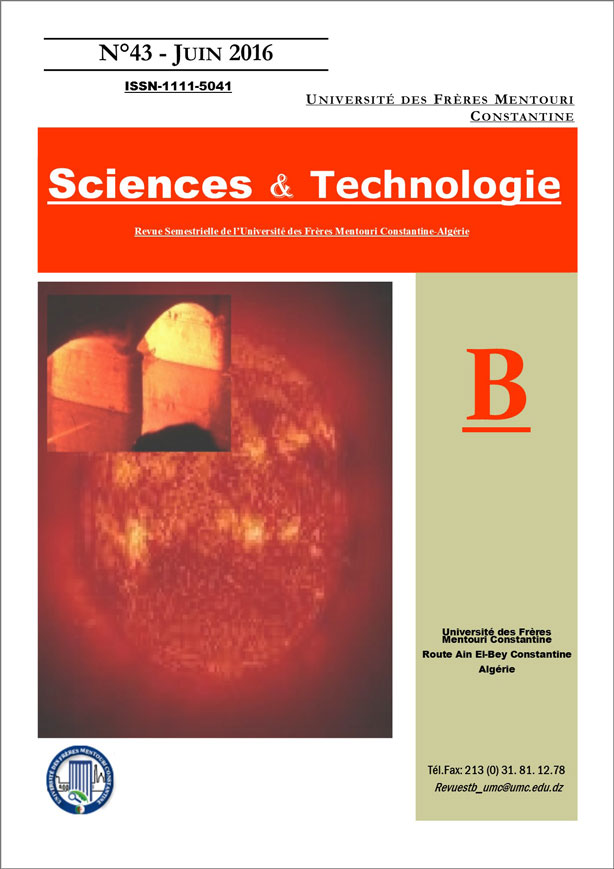L’EFFET DES PROPRIETES DU MATERIAU SUR LE COMPORTEMENT DU MODELE ELEMENT FINI DE FEMUR HUMAIN.
Mots-clés :
Fémur humain, Eléments finis, Orthotropie, IsotropieRésumé
La modélisation par éléments finis (EF) est devenue un outil incontournable dans les études biomécaniques. Les données CT ont été largement utilisées dans la modélisation par éléments finis de l’os. Dans notre travail un modèle 3D de fémur humain a été créé à partir de l’imagerie médicale (DICOM). Le modèle a été simulé avec des matériaux de différentes propriétés mécaniques (isotropie et orthotropie)fournies par les données CT (Computed Tomography), et sous des chargements physiologiques dans lecas d’appuibipodal. L’objectif principal de cette étude est d’analyserl’effet des propriétés et le comportement mécaniquesdu tissu osseux cortical ou trabéculaire sur les contraintes et les déformations du modèle de fémur humain.
Références
A. Schonning, B.Oommen, I.Ionescu, T. Conway. Hexahedral mesh development of free-formed geometry: The human femu rexemplified. Computer-Aided Design, 41 (2009). 566–572.
I T. Haider, A D. Speirs, H. Frei. Effect of boundary conditions, impact loading and hydraulic stiffening on femoral fracture strength. Journal of Biomechanics, 46 (2013). 2115–2121.
D. Belaid, A. Bouchoucha. Modeling of the Mechanical Behavior of the Human Femur: Stress Analysis and Strain. Athens : 11th International Conference of Computational Methods in Sciences and Engineering, 2015.
R. Allena, C. Cluzel,. Identification of anisotropic tensile strength of cortical bone using Brazilian test. journal of the mechanical behavior of biomedical materials, 38 (2014). 134-142.
H. Yang, X. Ma, T. Guo,.Some factors that affect the comparison between isotropic and orthotropic inhomogeneous finite element material models of femur.Medical Engineering & Physics,32 (2010).553–560.
V. Baca, Z.Horak, P. Mikulenka, V. Dzupa. Comparison of an inhomogeneous orthotropic and isotropic material models used for FE analyses. Medical Engineering & Physics, 30 (2008). 924-930.
L P. Jing Bai, X. Zeng, Y. Zhou, Comparison of isotropic and orthotropic material property assignments on femoral finite element models under two loading conditions. Medical Engineering & Physics, 28 (2006). 227–233.
B.Luisier, E. Dall'ara, D H. Pahr.Orthotropic HR-pQCT-based FE models improve strength predictions for stance but not for side-way fall loading compared to isotropic QCT-based FE models of human femurs. journal of the mechanical behavior of biomedical materials,32 (2014). 284-299
P K. Zysset, X E Guo, C E Hoffer, K E. Moore, S A. Goldstein. Elastic modulus and hardness of cortical and trabecular bone lamellae measured by nanoindentation in the human femur. Journal of Biomechanics, 32 (1999). 1005-1012.
C H. Turner, J Rho, Y Takano, T Y. Tsui, G M. Pharr , . The elastic properties of trabecular and cortical bone tissues are similar: results from two microscopic measurement techniques. Journal of Biomechanics, 32 (1999). 437-441.
R L. Austman, J S. Milner, D W. Holdsworth, C E. Dunning. The effect of the density–modulus relation ship selected to apply material properties in a finite element model of long bone. s. Journal of Biomechanics, 41 (2008). 3171–3176.
A. Cong, J O D. Buijs, D D. Daescu. In situ parameter identification of optimal density–elastic modulus relationships in subject-specific finite element models of the proximal femur. Medical Engineering & Physics, 33 (2011). 164–173.
E F. Morgan, H H. Byraktar, T M. Keaveny,. Trabecular bone modulus–density relationships depend on anatomic site. Journal of Biomechanics, 36 (2003). 897–904.
Téléchargements
Publié-e
Comment citer
Numéro
Rubrique
Licence
Les auteurs publiant dans cette revue acceptent les termes suivants :- Les auteurs détiennent le droit d'auteurs et accordent à la revue
le droit de première publication, avec l’ouvrage disponible simultanément [SPÉCIFIER LA PÉRIODE DE TEMPS] après publication, sous la licence Licence d’attribution Creative Commons qui permet à d'autres de partager l'ouvrage en en reconnaissant la paternité et la publication initiale dans cette revue. - Les auteurs peuvent conclure des ententes contractuelles additionnelles et séparées pour la diffusion non exclusive de la version imprimée de l'ouvrage par la revue (par ex., le dépôt institutionnel ou la publication dans un livre), accompagné d'une mention reconnaissant sa publication initiale dans cette revue.
- Les auteurs ont le droit et sont encouragés à publier leur ouvrage en ligne (par ex., dans un dépôt institutionnel ou sur le site Web d'une institution) avant et pendant le processus de soumission, car cela peut mener à des échanges fructueux ainsi qu'à un nombre plus important, plus rapidement, de références à l’ouvrage publié (Consulter The Effect of Open Access).

